The Ultimate Guide to Content Team Roles and Responsibilities
Ever felt like you’re spinning more plates than a circus performer when managing your content? It’s a tale as old as time. At least, it feels that way if you’re in B2B marketing.

Your daily to-do is a smorgasbord of different roles. You're the writer, the strategist, the social media guru, and, let's be real, part-time graphic designer. Overwhelmed? You're not alone.
But what if you could turn that havoc into a well-tuned symphony? A content team where everyone plays their part, seamlessly integrating like a band in perfect harmony (even better than Brozone in Trolls 2).
This isn’t wishful thinking. It's entirely achievable. With the right content marketing team structure in place, you can transform your one-man band into a content orchestra that scales with your business effortlessly.
Doing more with less may be the ever-lasting mantra, but it doesn’t mean you can’t make it more effective and sustainable.
The Changing Beat of Content Teams
Rewind a few years, and you’ll find most content strategies embracing 'more is more!'—more content, more channels, faster output. But let's face it, this often meant compromising on quality and strategic alignment.
Content marketing team structures were built for speed, not sustainability.
Fast forward to today, and the tune has changed. We're shifting towards leaner, more strategic content operations where every piece of content must justify its existence in an increasingly crowded digital space. Modern content marketing team roles are more defined, focusing on quality over quantity.
Why? Because digital channels are saturated, only the sharpest B2B content cuts through the noise. A startling stat from Beam Research shows just how much we’re missing the mark: only 8% of content marketers feel that their wider GTM teams grasp the essence of content marketing, compared to 19% of non-content marketers who believe they have it nailed.
This 11% gap highlights a critical need for better communication and a deeper understanding of content’s role across teams.

Source: Beam
So, what’s the future look like? Picture fewer solo acts and more orchestral ensembles, where roles are so well-defined that each member knows their part by heart, allowing for performances that resonate far beyond the meeting room. With the right content marketing team structure, achieving this isn’t just possible—it’s inevitable.
Let's dive into how you can tune each section of your content band to play in perfect harmony.
Meet Your Content Dream Team
Ever felt like every content piece from your team was a chart-topper? That's the dream, right? Well, it's not just a fantasy. Think of your content marketing team structure as a rock band where each member knows their instrument inside out, syncing up to deliver a mind-blowing performance. Let’s meet the band:
- Content Strategist: Picture this person as the band leader, setting every piece's rhythm and mood. Like a lead guitarist riffing out the melody that'll catch everyone's ear, the strategist outlines your content's direction, ensuring every tune aligns with your business goals.
- Content Manager: Reliable as the drummer in the back, keeping everyone on beat. They ensure that every content piece hits the stage at just the right moment, maintaining a steady flow and keeping the whole show running smoothly. This role is crucial in building and managing a content marketing team effectively.
- Content Writer/Editor: These are your vocalists and lyricists, the heart and soul of your band. Writers bring the creativity, crafting messages that resonate and stick with your audience, while editors refine the pitch, ensuring every note is in perfect harmony.
- SEO Specialist: Think of them as the sound engineers, tweaking the acoustics to ensure your music reaches every corner of the venue. They optimize your content to ensure search engines amplify your content, bringing more eyes and ears to your stage. Their role is vital in managing a content marketing team for maximum reach and impact.
- Graphic Designer: The visual artists of the band—making sure that the band sounds and looks good. They create visuals that complement your words, from stunning infographics to sleek web layouts, enhancing the overall experience.
- Social Media Manager: Your band’s promoters, working the social media crowds, ensuring your content gets the buzz it deserves and that the conversation continues long after the show is over. Their role in the content marketing team structure is essential for amplifying reach and engagement.
- Data Analyst: The behind-the-scenes gurus analyzing ticket sales and audience reactions, providing insights on what’s working, what’s not, and where to tweak the act for the next live show. They help measure the results and ROI of your content marketing efforts and adjust strategies for better performance.
Success Stories in the Wild
Imagine a team so well-coordinated that even the sales team moves in rhythm. Nicola Wylie’s setup ensures content is perfectly tailored to their audience, making every release feel like a hit single.
Nicola works at Filestage, a SaaS company with a small, agile content team: one content writer, one copywriter (Nicola), and a manager who handles both roles. They also collaborate with freelance writers. What makes their team effective is the seamless integration with the wider company, especially the sales team and other stakeholders:
- Sales Insights: The sales team records demos, providing valuable insights directly from customer interactions.
- ICP-Focused Slack Channel: A dedicated channel for sharing news, insights, and trends related to their Ideal Customer Profile (ICP) keeps the content team updated and aligned.
- CEO's Insights: The CEO shares customer interview insights, ensuring the content reflects real customer needs and experiences.
These practices help Nicola’s team create content that resonates with their audience and drives success. They produce precise, impactful content by working closely with sales and leveraging insights from across the organization.
Leigh McKenzie’s team at Backlinko is playing a smart game by meticulously tracking content performance and using data to outshine the competition. Their approach is like setting a high score that no one else can beat.
Leigh’s team uses a detailed process to scale their content marketing effectively:
- Data-Driven Planning: They base their content planning on how well similar topics perform on platforms like semrush.com, using URL-level revenue attribution to focus on the most impactful topics.
- Organized Workflow: By breaking down their writing process into tiny steps, creating detailed content briefs, and using organized content calendars, they manage to publish about 50 high-quality articles per month. Each team member has a distinct role, reporting directly to Leigh as the head of SEO, ensuring a smooth and streamlined workflow.
- Cross-Functional Collaboration: Leigh’s team collaborates closely with domain experts and SMEs, ensuring their content is authoritative and accurate.
- Iterative Improvement: They continuously review performance metrics, iterate, and improve their processes, ensuring content remains top-notch.
- Specialized Roles: The team's structure allows for a highly efficient content creation process:
- The growth manager identifies promising keywords and later creates newsletter announcements for new pieces.
- The SEO manager selects content formats, creates briefs, conducts final reviews, and performs quality checks before publication.
- Writers outline and craft the content.
- Editors refine the pieces.
- Designers create visuals.
- Publishers handle screenshots and stage content on the website.
“Creating a step-by-step production process really helps us understand what’s happening and becomes much easier to find opportunities to optimize at each step.”
This well-oiled machine of a content team allows Backlinko to maintain high quality while scaling production. Each step, from keyword research to newsletter announcement, is carefully orchestrated to ensure maximum impact. The clear division of responsibilities and Leigh's direct oversight keep the process running smoothly, allowing the team to focus on creating content that truly resonates with their audience.
These strategies have enabled Backlinko to maintain content quality while increasing organic traffic sessions by 31.3% year-on-year, proving that a well-structured, data-driven content marketing approach can drive significant growth and success.
Diverse Team Structures for Every Stage
Not every band looks the same, and neither do content teams. Whether you're a solo act or part of a big production, there's a setup that fits your style.
Small Teams: The Agile Solo Act
Flying solo? You’re in good company, with nearly 80% of small business owners and marketers managing their own content. It's agile, yes, but without some clever tricks, it can quickly lead to burnout.
Content marketing with a small team almost always means wearing multiple hats and taking on multiple roles. This can be a double-edged sword of fun and learning combined with too much context-switching and silly slip-ups from human error.
“Driving the pipeline is important but so is good content that delivers value. Don't sacrifice one for the other!”
Medium to Large Teams: The Full Orchestra
Larger companies often resemble a full orchestra, with a centralized team where everyone knows their part, ensuring the symphony plays flawlessly together.
Nicole Lee at Upland Software showcases a perfectly tuned orchestra. Her team’s regular meetings with sales, product, and marketing ensure that everyone plays from the same sheet, creating harmonious content that drives their business objectives.
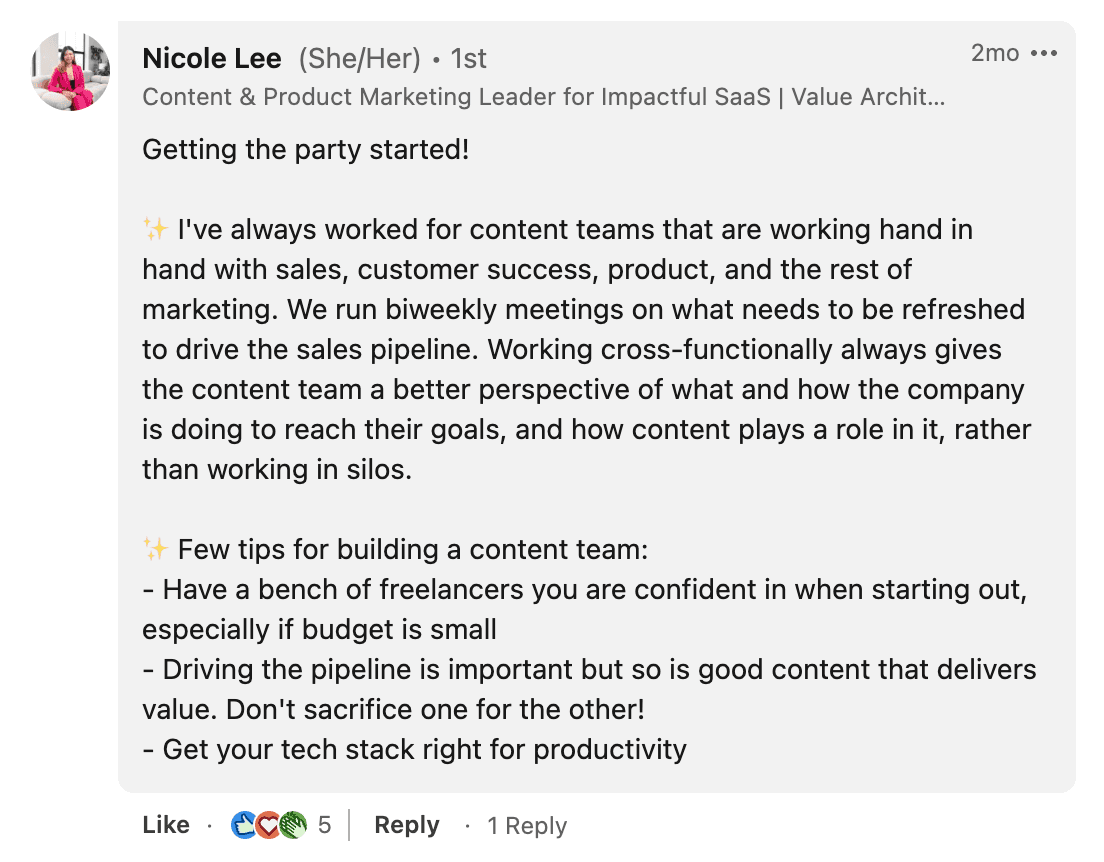
Source: LinkedIn
Fractional Content Managers: The Guest Artists
Not quite ready for a full-time conductor? Fractional managers step in like guest artists, helping to orchestrate your content strategy without the commitment of a full-time leader.
Harmonizing Departments for Content Success
Imagine orchestrating a festival tour. It's not just the spotlight acts that create a hit show but also the seamless integration of every crew member, from sound techs to stage managers. Similarly, the symphony of content creation involves everyone from the content team to product, customer success, and sales—each playing a pivotal role in the grand performance.
Amplifying Collaboration Across GTM
The harmony between content teams and other departments is crucial. Yet, only half of GTM professionals report positive experiences from their involvement in content marketing—despite 95% believing their involvement would significantly enhance content’s relevance and effectiveness.
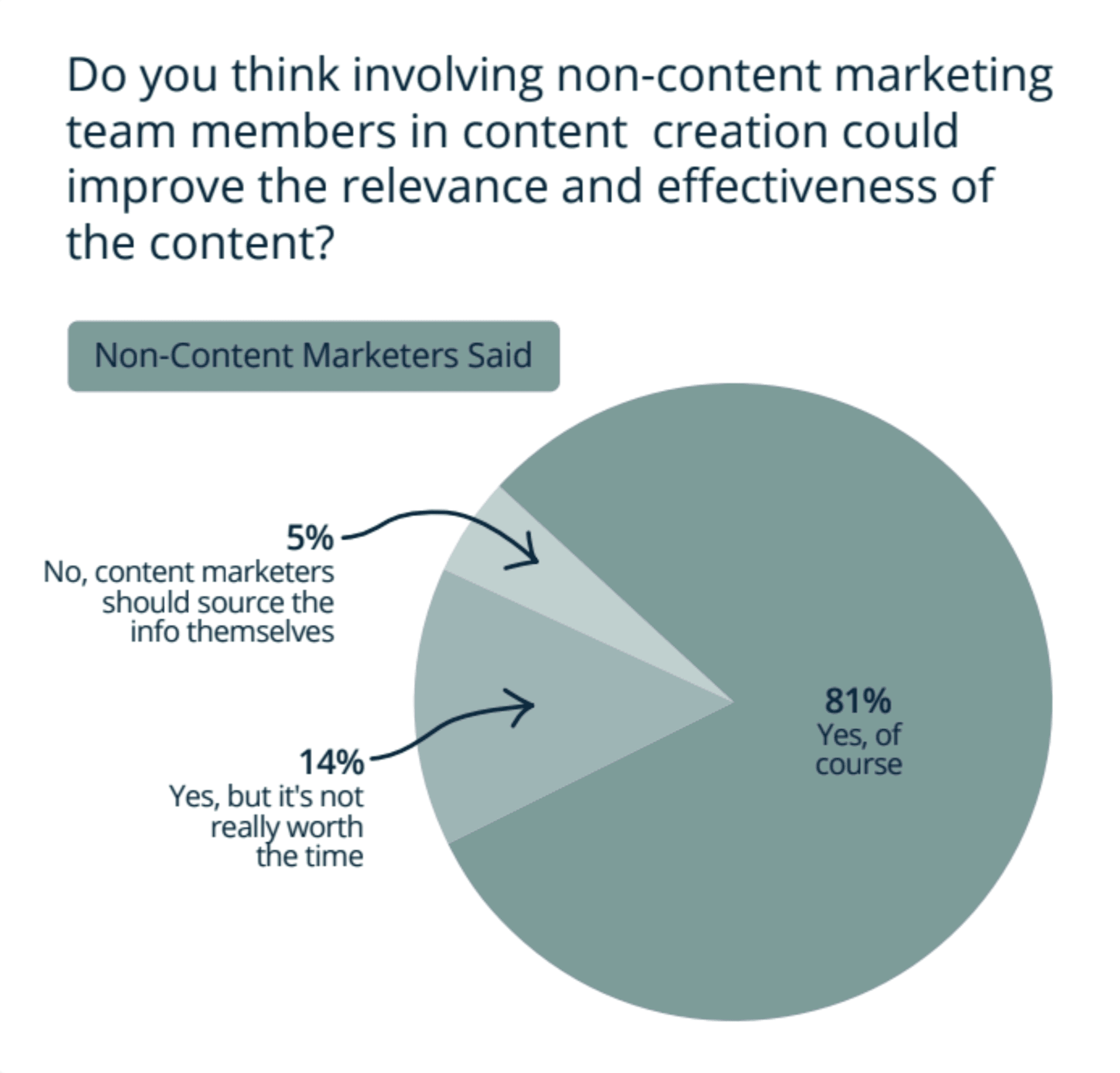
Source: Beam
This presents a critical opportunity for content teams to fine-tune their collaborative processes, ensuring that every department’s voice is heard and is integral to the content's composition.
Nicole masterfully demonstrates how to lead this setup. She conducts biweekly strategy sessions, viewed as crucial jam sessions where sales, marketing, and product teams sync their rhythms. This strategic ensemble ensures that the content resonates across every customer touchpoint, delivering a unified message that amplifies business objectives.
Meriqua Danni White from DW Creative Consulting Agency also tunes into this concept beautifully.
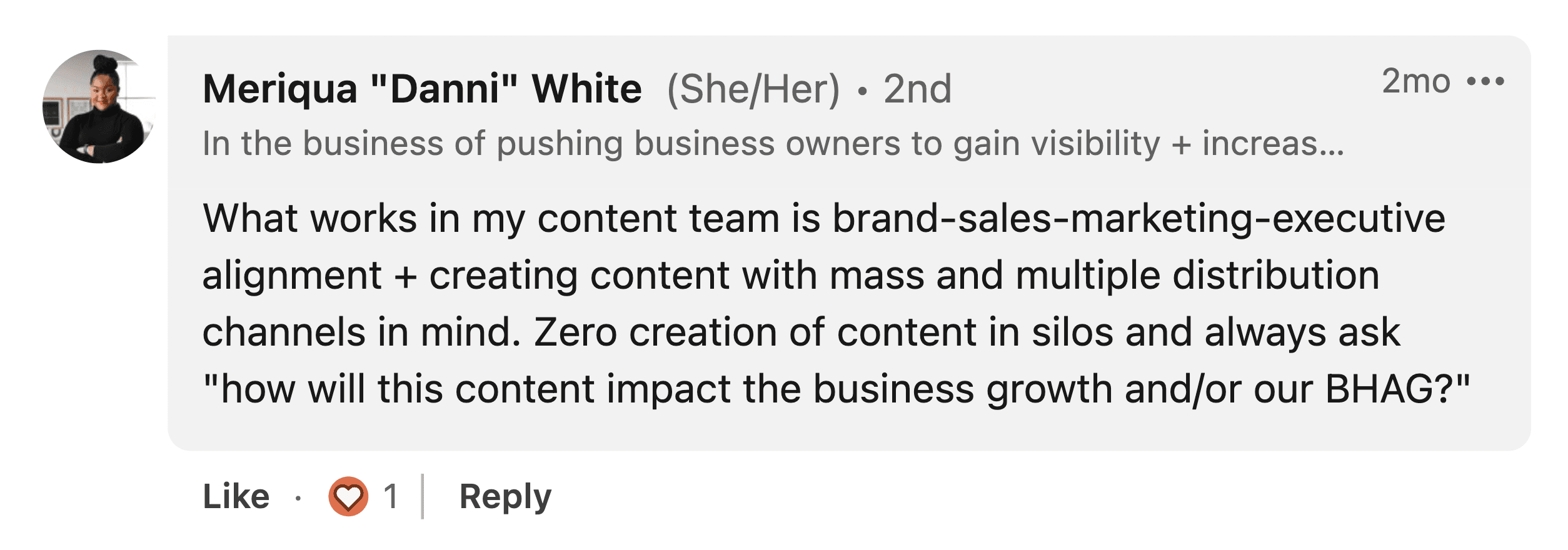
Source: LinkedIn
She advocates for a concert where brand, sales, and marketing align with the executive vision. She emphasizes that content should never be a solo act but a core part of driving business growth and achieving ambitious goals. By integrating C-suite priorities into the content strategy, content becomes a pivotal element in the organization's overarching strategy.
In this collaborative arena, content marketers must ensure that their efforts are not standalone performances but integrated acts that leverage insights from across the business landscape. This approach enhances the relevance of content and ensures it plays a crucial role in the company's broader business strategy. Think of it like a headliner that draws crowds and defines the success of a festival.
Back to the Roots with Founder-Led Marketing
Effective content strategy hinges on leadership. When founders guide content creation, they bring unique depth and authenticity that resonates deeply. Their vision and values infuse content, creating a powerful connection that aligns with long-term business goals.
Take David Baum, the founder of Relato. His daily work focuses on building the product, but his conversations with prospective customers also shape Relato's content strategy. "All product development starts with customer insight," David explains. "The conversations I have with our prospective customers inform our content strategy just as much as they inform our product roadmap."
“The conversations I have with our prospective customers inform our content strategy just as much as they inform our product roadmap.”
David's approach highlights the strong link between understanding customer needs and building a meaningful audience. As Relato develops its platform, it grows its audience simultaneously. This feedback loop of build-measure-learn drives product improvements and fuels content creation. "The posts that gather the most engagement on LinkedIn tell me what to prioritize for long-form content," David notes. This strategy ensures Relato invests in content that aligns with business goals, showcases platform features, and resonates with the audience.
Imagine every piece of content carrying the founder's vision and harmonizing with the long-term business strategy, like a signature riff everyone recognizes. When founders lead content strategy, they craft a legacy that balances short-term engagement with sustainable growth.
Incorporating the founder’s perspective transforms content from fleeting interactions to enduring narratives that reflect the brand’s core values. This approach embeds the founder’s ethos into every piece, ensuring that each campaign, blog post, or social media update contributes to a grander vision.
Bridging Immediate and Long-Term Goals
Often, marketers see content marketing as a long game, overshadowed by the pressure to deliver quick results. Founder-led marketing bridges this gap by shifting the focus from rapid gains to building lasting relationships and driving long-term revenue.
Using the founder’s voice adds authenticity and turns each content piece into a compelling narrative that captivates and engages the audience. Leveraging the founder's unique stories, personal insights, and visionary foresight crafts content that fills the hearts of your audience, turning casual listeners into loyal fans.
Streamlining Your Content Team for Peak Performance
Maximizing efficiency in your content team is like perfecting a live performance. It requires preparation, the right tools, and a bit of improvisation. Here’s how to keep your content band playing in perfect harmony.
Standard Operating Procedures (SOPs)
If your content creation process feels like reinventing the wheel every time, you need some SOPs in your life. Ioana Wilkinson, a freelance SEO strategist, shouts from the rooftops about it.
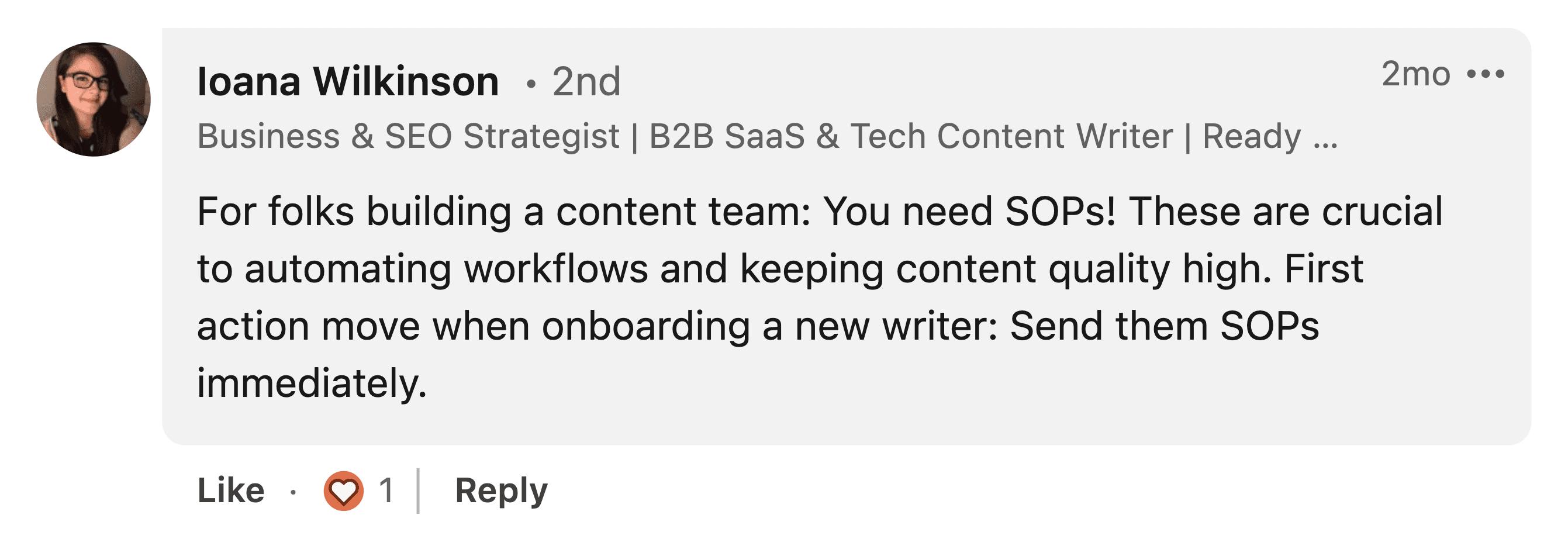
Source: LinkedIn
SOPs aren’t just paperwork—they’re your roadmap to ensuring everyone’s singing from the same song sheet. First thing Ioana does with a new writer? Hand over the SOPs.
It's like tuning your guitar before hitting the stage—it makes everything sound better. SOPs streamline workflows and keep content quality high, making them essential for onboarding new team members and maintaining consistency.
The Perfect Tech Stack
And speaking of smooth, let’s talk tech stacks. Nicole Lee has a solid tip: get your tech stack right.
It's like getting the right pedals and amps. The better your equipment, the better your performance, and the sweeter your content rings out. A well-chosen tech stack can enhance productivity, facilitate collaboration, and ensure your team has the tools to excel.
Building a Solid Freelancer Bench
Got a fluctuating content calendar that’s more unpredictable than a rock star’s tour dates? That’s where your freelancer bench comes in. Nicole Lee knows the drill—keep a solid lineup of trusted freelancers ready.
It’s like having session musicians who can jump in and keep the show going, no matter what. A reliable bench of freelancers allows you to scale your content production up or down based on demand, ensuring you never miss a beat. Just be sure you have a freelance onboarding process that saves them time and saves you a headache.
Cross-Channel Content Repurposing
And when you hit that perfect note, you want to ensure it echoes across all channels, right? Josh Spilker’s got a strategy for that: start with a bang in one channel, then remix that content to resonate across others. It’s about maximizing the reach of your hits without draining your creative juices.

Source: LinkedIn
For instance, expand a well-received social media post into a blog post. Or turn a successful webinar into a series of articles. This approach amplifies your content efforts across various platforms, reaching a wider audience.
Cornerstone Content: Your Greatest Hits
Last up, let’s talk big hits—your cornerstone content. These are your chart-toppers, the ones that define your sound. Tom Shapiro from Stratabeat sets up anthems like the 'B2B SaaS SEO Benchmark Report' and his book 'Rethink Lead Generation.' These pieces are lead magnets, conversation starters, and brand builders all rolled into one.
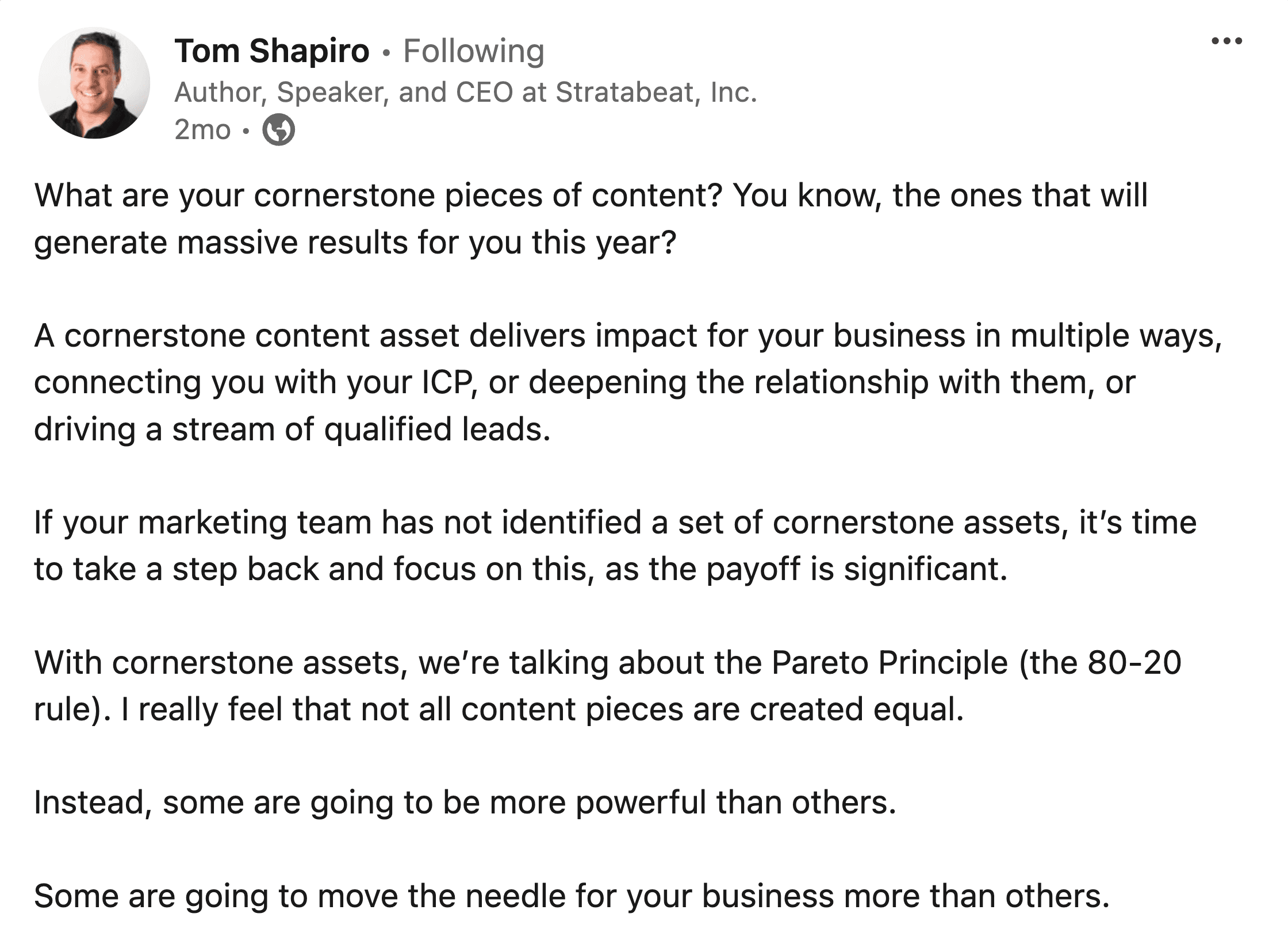
Source: LinkedIn
Cornerstone content delivers massive impact for your business by connecting deeply with your ICP, driving qualified leads, and establishing your authority in the industry. It’s like having a greatest-hits album that keeps generating interest and revenue over time.
Challenges in Content Team Management
Let's face it—managing a content team can sometimes feel like trying to perform a perfect live set. Sometimes, you nail it, other times you may have some “technical” difficulties. Here’s the insider’s view on what trips up most bands:
- Creating the Right Content: About 61% of technology marketers are like songwriters in the dark, trying to pen a hit without knowing what the audience wants.
- Content Differentiation: With 58% struggling here, it’s akin to trying to stand out at a festival packed with headliners. How do you make sure your tune isn’t lost in the noise?
- Consistent Content Creation: For 49% of marketers, keeping the hits coming is as tough as a non-stop tour.
- SEO Optimization: For 43%, topping the search charts is as tough as getting a number one hit.
- Technical Skills: 36% are looking for that rare keyboard player who can actually read music and play.
And then there are the behind-the-scenes challenges:
- Lack of Resources: 66% are trying to stage stadium tours on a garage band budget.
- Aligning Content Efforts: Syncing the dance moves of marketing and sales is a tough choreography for over half.
- Accessing Subject Matter Experts: 45% say snagging time with these rockstars for insights is as hard as scoring backstage passes.
- Workflow Issues/Content Approval Processes: 44% find themselves tangled in their own equipment, tripping over clunky workflows.
Building Your All-Star Content Team
So you’re ready to form your band? Here’s how to start your own content rock group:
Assessing Your Needs
Start by scoping out the size of the venue, so to speak. Does your company's stage (market reach and goals) require a full orchestra or just a tight, nimble jazz trio? This will guide the scale and composition of your team.
Crafting a Winning Hiring Strategy
Every band needs a leader, and so does your content team. Start with a content strategist, the conductor who can ensure everyone is in sync. If the budget’s tight, consider a fractional strategist to lead the charge without a full-time commitment.
Smart Hiring Tips
Think about the genre of music you’re playing (the type of content you’re producing). Do you need a bassist with a funky slap to jazz things up or someone who can hold down a smooth, steady rhythm? Each role in your team should complement the overall performance.
“Help ICs understand how their work fits in the big picture.”
Make sure everyone knows their parts. Josh Spilker suggests letting each individual contributor (IC) know the role of their piece—whether it's the headliner (top of funnel) or the encore (bottom of funnel).
“Help ICs understand how their work fits in the big picture. Let them know the function of the piece (top/mid/bottom) and how the individual pieces fit together.”
— Josh Spilker, Head of Marketing, Tettra
Prioritizing Experience Over Degrees
Just like in music, where ears often matter more than formal training, prioritize hands-on experience and a proven track record over formal degrees. Look for a portfolio that sings.
Bare Minimum Must-Haves
At the very least, make sure you have your key players in place: a lead vocalist (Content Strategist), a drummer to keep the rhythm (Content Manager), and a lead guitarist to riff through the market noise (SEO Specialist).
Bringing It All Together
We’ve jammed through the what, why, and how of setting up a killer content team. From laying down the rhythm with the right roles to keeping the harmony with cross-departmental collaboration and streamlining the gig with slick SOPs and tech, you can do a lot to make your content sing.
All marketers are striking a similar chord: the role of content marketing will only grow louder and more critical. With this rising crescendo comes the challenge that nearly every band faces—creating consistent, high-quality content that captivates and keeps the audience coming back for more encores. This shared perspective highlights the need for content teams to innovate and evolve, ensuring the music never stops and always resonates.
Feeling inspired to tweak your content strategy or maybe even overhaul your whole setup? Now’s the time to tune up and prepare for the future. So, grab these insights, get your band together, and start making some noise in the content scene! This is your moment to turn up the volume of your content strategy and orchestrate a performance that truly rocks the digital landscape.
Are you ready to amp up your content program? Sign up for early access and snag our Freelancer Onboarding Checklist to ensure every new writer is stage-ready from day one. Let’s rock this content festival and set the stage for a future where your content will perform and lead the show.